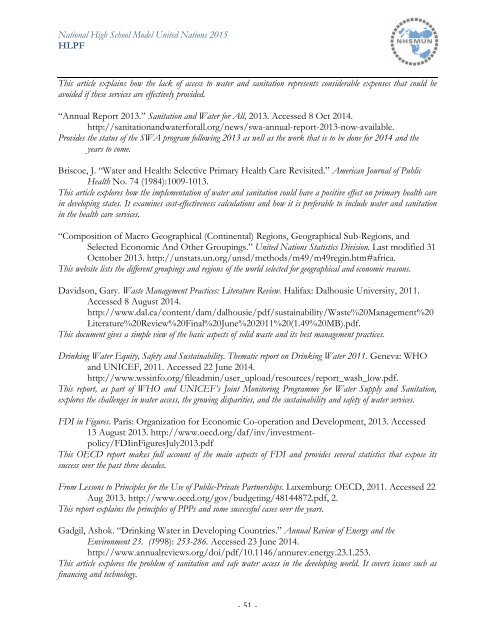d5MrHv
d5MrHv
d5MrHv
Create successful ePaper yourself
Turn your PDF publications into a flip-book with our unique Google optimized e-Paper software.
National High School Model United Nations 2015<br />
HLPF<br />
This article explains how the lack of access to water and sanitation represents considerable expenses that could be<br />
avoided if these services are effectively provided.<br />
“Annual Report 2013.” Sanitation and Water for All, 2013. Accessed 8 Oct 2014.<br />
http://sanitationandwaterforall.org/news/swa-annual-report-2013-now-available.<br />
Provides the status of the SWA program following 2013 as well as the work that is to be done for 2014 and the<br />
years to come.<br />
Briscoe, J. “Water and Health: Selective Primary Health Care Revisited.” American Journal of Public<br />
Health No. 74 (1984):1009-1013.<br />
This article explores how the implementation of water and sanitation could have a positive effect on primary health care<br />
in developing states. It examines cost-effectiveness calculations and how it is preferable to include water and sanitation<br />
in the health care services.<br />
“Composition of Macro Geographical (Continental) Regions, Geographical Sub-Regions, and<br />
Selected Economic And Other Groupings.” United Nations Statistics Division. Last modified 31<br />
Octtober 2013. http://unstats.un.org/unsd/methods/m49/m49regin.htm#africa.<br />
This website lists the different groupings and regions of the world selected for geographical and economic reasons.<br />
Davidson, Gary. Waste Management Practices: Literature Review. Halifax: Dalhousie University, 2011.<br />
Accessed 8 August 2014.<br />
http://www.dal.ca/content/dam/dalhousie/pdf/sustainability/Waste%20Management%20<br />
Literature%20Review%20Final%20June%202011%20(1.49%20MB).pdf.<br />
This document gives a simple view of the basic aspects of solid waste and its best management practices.<br />
Drinking Water Equity, Safety and Sustainability. Thematic report on Drinking Water 2011. Geneva: WHO<br />
and UNICEF, 2011. Accessed 22 June 2014.<br />
http://www.wssinfo.org/fileadmin/user_upload/resources/report_wash_low.pdf.<br />
This report, as part of WHO and UNICEF’s Joint Monitoring Programme for Water Supply and Sanitation,<br />
explores the challenges in water access, the growing disparities, and the sustainability and safety of water services.<br />
FDI in Figures. Paris: Organization for Economic Co-operation and Development, 2013. Accessed<br />
13 August 2013. http://www.oecd.org/daf/inv/investmentpolicy/FDIinFiguresJuly2013.pdf<br />
.<br />
This OECD report makes full account of the main aspects of FDI and provides several statistics that expose its<br />
success over the past three decades.<br />
From Lessons to Principles for the Use of Public-Private Partnerships. Luxemburg: OECD, 2011. Accessed 22<br />
Aug 2013. http://www.oecd.org/gov/budgeting/48144872.pdf, 2.<br />
This report explains the principles of PPPs and some successful cases over the years.<br />
Gadgil, Ashok. “Drinking Water in Developing Countries.” Annual Review of Energy and the<br />
Environment 23. (1998): 253-286. Accessed 23 June 2014.<br />
http://www.annualreviews.org/doi/pdf/10.1146/annurev.energy.23.1.253.<br />
This article explores the problem of sanitation and safe water access in the developing world. It covers issues such as<br />
financing and technology.<br />
- 51 -


